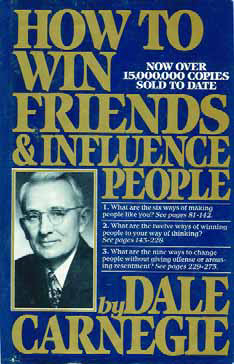The Art of Influence

In this business, there’s no avoiding the fact that you have to be able to work with people.
That may seem an obvious point, but if you’re like me and tend toward the shy side, stepping out of your shell to work with others is not always easy. I’ve always admired those with easy-going social skills, but I’ve never been one of them – and I know in this industry that I’m far from alone.
In my case, I’ve found my way around my basic tendencies by taking advice I’ve found to be incredibly helpful in my work with clients as well as in my relationships with sub-contractors and fellow employees. That advice comes from one of the true classics of 20th-century American publishing, none other than Dale Carnegie’s How to Win Friends and Influence People.
If you’re not familiar with this volume beyond its name, you might be impressed by the fact that Carnegie’s seminal self-help book was first published in 1936 and has been available and in print ever since. My copy was published in 1981 (the revised edition from Simon & Schuster), and by that time, more than 15 million copies had been sold worldwide.
Carnegie’s work is the basis for courses that have been taught for decades, and countless business leaders and politicians have cited his ideas about how to work effectively with people as major personal influences.
There’s a reason this material has been so enduring despite its age: Carnegie had an incredible knack for highlighting the profound importance of some of the simplest of social skills – things we all should (and probably do) know but all too often forget to apply as we make our way through our daily lives.
The book has 30 short chapters, each about 10 pages in length. Each chapter be read in just a few minutes, and I like to read them one at a time so I’m sure to absorb the ideas and advice he shares on each and every page. The chapters are divided into four sections, one on the fundamentals of handling other people; another on ways to make people like you; a third on how to turn people to your way of thinking; and, finally, one on how to be a leader without giving offense or arousing resentment. Each features terrific examples and vignettes mixed in with phenomenally sage advice.
Most often, that advice comes in extremely simple forms, as in his discussion of the power of the sincere compliment or of the importance of remembering to smile when dealing with others. One of my favorites is his discussion of “giving people a high reputation to live up to.” This is something I’ve found particularly useful in all sorts of ways in all parts of my life: When you set a high standard for others and let them know that you expect great things from them, it’s amazing how consistently they will work to live up to that reputation.
There are so many great little thoughts and ideas in Carnegie’s book that I keep coming back to it again and again – at times on a daily basis. The material is that integral to building effective business (and personal) relationships, and it’s critical not only to read what Carnegie says, but also to spend time reflecting on it and then taking steps to apply it.
Fortunately, applying these ideas is mostly about reminding ourselves about basic truths of human nature – in other words, things we already know. If you find yourself challenged by the thought of working with customers and others, you might just find this classic to be well worth a permanent spot on your bookshelf, just as I have.
Mike Farley is a landscape designer with more than 20 years of experience and is currently a designer/project manager for Claffey Pools in Southlake, Texas. A graduate of Genesis 3’s Level I Design School, he holds a degree in landscape architecture from Texas Tech University and has worked as a watershaper in both California and Texas.










